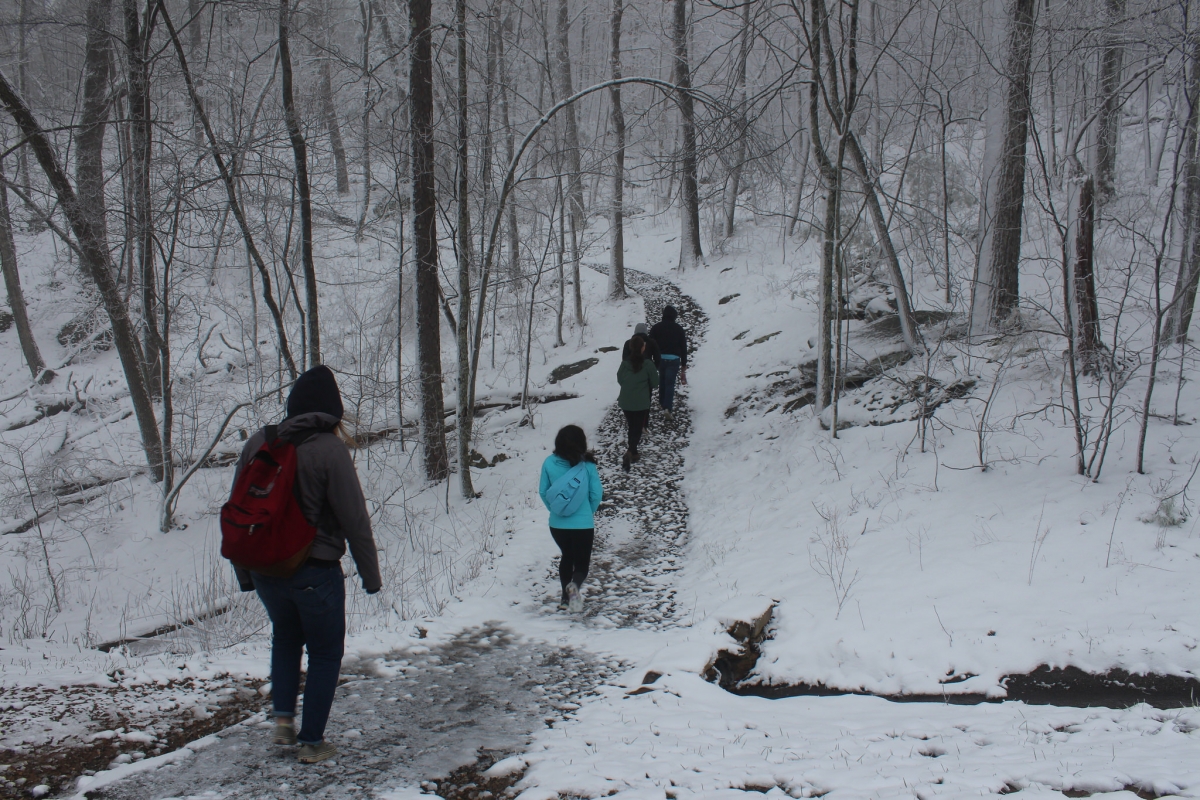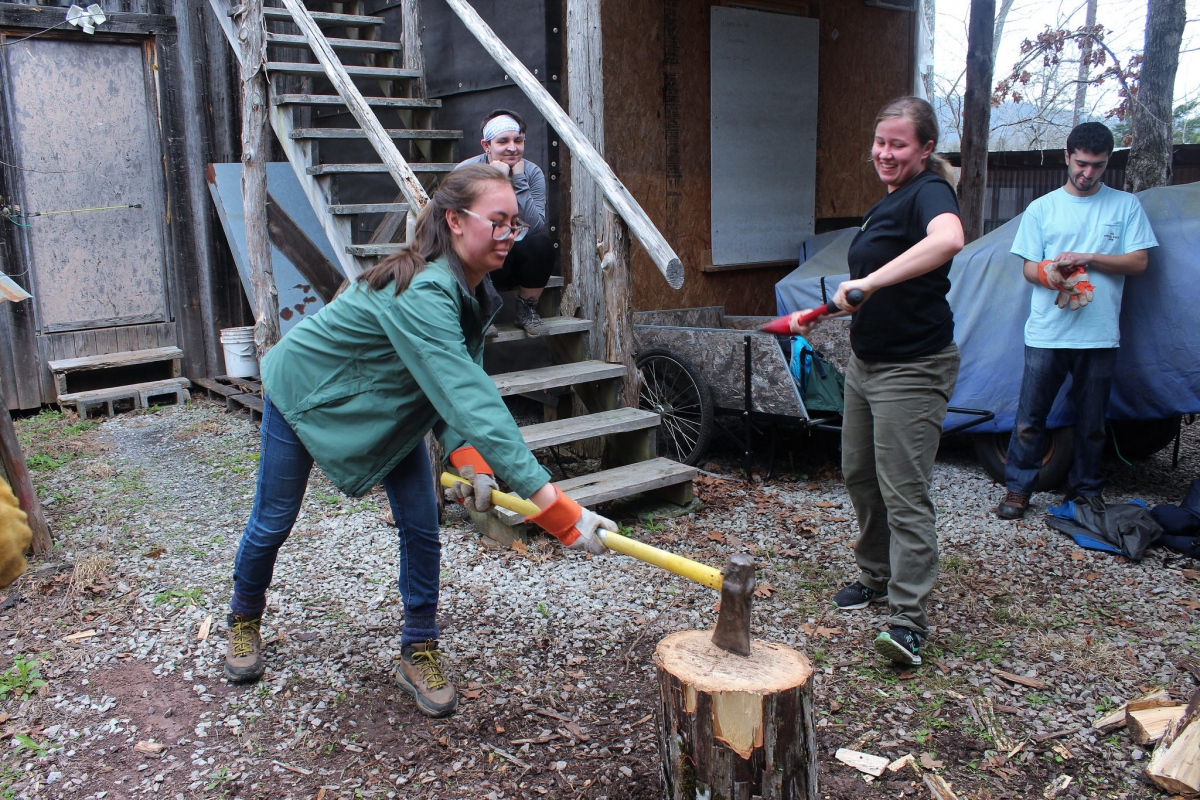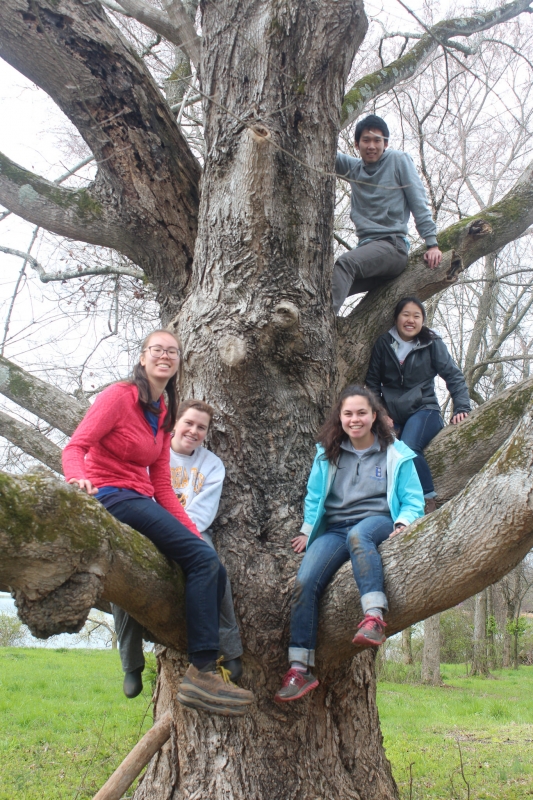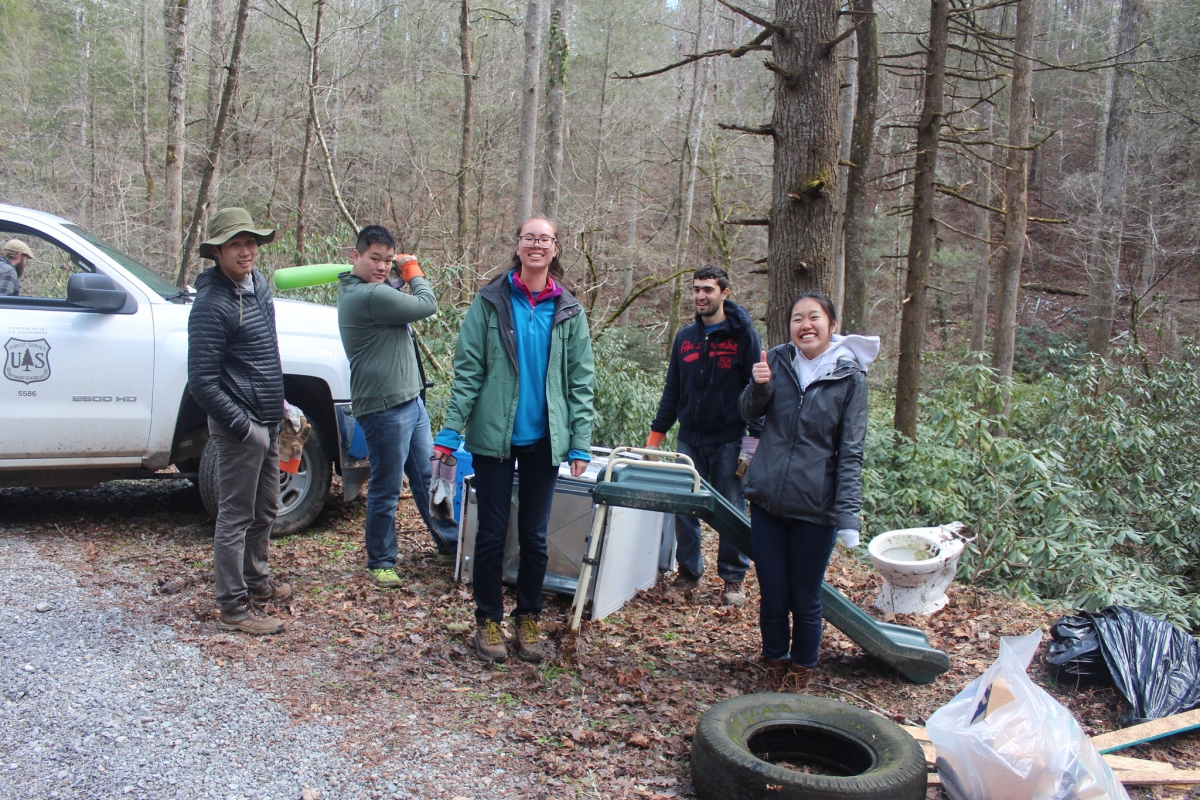By: Adrianna Fu
My trip to Maryville, TN encompassed all the aspects of serve, learn, and sustain—and so much more. I selfishly think that I gained more from this trip than I gave—but then I pause and remember that we picked up nearly a ton of garbage, cleared out trails for future hikers, and even had the opportunity to honor the Cherokee people by restoring a burial ground. This week was a definite departure from the grind of school and extracurriculars, but not in the way I expected. First of all, I met and worked with some amazing people; the Maryville ASB team was surprisingly diverse, and I loved that everyone was coming in with different experiences and perspectives. Our hosts at Once Upon A Time, Ed and Arleen, were also the sweetest people I’ve ever met; they somehow became our grandparents for the week, even though they see around 160 students come through their home every year.
This couple leads such an extraordinary lifestyle; their entire March is filled with students coming in and out of their home. While the service only lasts a week for us students, Ed and Arleen go out to the project sites with a different group every week and have built up genuine relationships with the people they work with. They reminded me that service does not have to be a temporary thing—it can become a part of the way I live and treat my surroundings. I learned to take only what I need from the earth, and furthermore, how to respect what the earth has already plentifully provided for me. Some nights got very cold (we even saw snow!) and we stayed warm by burning firewood that previous ASB groups had chopped. We also had the opportunity to pay it forward by chopping wood for future groups.
It was such a unique experience to spend the week learning what it meant to love the earth and love other communities. Although the work wasn’t easy and I got my hands dirty more than once, I would undoubtedly do it all over again if I could. Sustainability is on my mind now more than ever, and I’m so grateful that I had the opportunity to learn more about it through the lens of this ASB trip.
By: Mirela Vojnikovic
We departed from the traffic and noise of Atlanta, Saturday March 18th, for the quiet and calm of the Tennessee Smokey Mountains. I didn’t really have any expectations going in to this adventure as this was my first ASB trip. I was told that there would likely be no cell service on this trip and that most of the activities would take place outdoors, and that was enough to get me involved. I was looking forward to leaving my twitter behind in exchange for the chirping of actual birds.
We arrived after a short 3-hour drive to a small property in the woods encompassed by tress and gorgeous views of the surrounding mountains. Our incredible hosts Ed and Arleen gave us a quick tour of the “facilities” before we put our things away. Arleen explained how her husband Ed had built the 3 cabins and tool shed by himself at the ripe old age of 60! He was a furniture builder by trade, so not only had he built these structures with his hands and the trees on the property, but he outfitted them with handmade furniture, again built with lumber taken from the surrounding forest. We picked the “Cabin with a View” facing the breathtaking mountainous scenery and set our things down. Later on, we listened to a presentation on Cherokee History and traditions by a local Cherokee Warrior member ,Archie Reynolds, who really opened our eyes to the obvious beauty of the Cherokee culture which we delved further into throughout the week. He mentioned the importance of sustainability in preserving this planet of ours, and followed by showing us evidence of how the Native Americans used all parts of the animals they killed to both reduce waste and honor the life that was taken to feed another.
This theme of sustainability followed us throughout the week. Ed and Arleen’s efforts toward running a sustainable property were obvious in almost all corners. Lights in the cabin were expected to remain off until needed to reduce electricity use. The guest cabins as well as the couple’s personal home were all outfitted with wood burning heaters. Arleen informed us that the AC was almost never used. Wood burning kept things nice and warm in winter while the windows were cracked open in the summers to again avoid unnecessary electricity usage. There were no flushable toilets on the property, to my initial dismay. However, we became very used to using outhouses as opposed to regular toilets, and the positive environmental impact of reducing waste water was immense and well worth the slight discomfort of using an unheated, unlit outhouse.
Every meal was eaten in the dining room which was part of Ed and Arleen’s personal home. The dining room had a compost bucket, recycle bin, as well as a regular trash can, and each individual was expected to properly sort their waste to minimize what was being sent to landfills. On the days when we left the property to perform service projects, we packed our lunches in reusable plastic containers which we kept thought the week and returned (washed) at the end. Our lunch bags were reusable sacks hand sown by Arleen to reduce the need for plastic.
This trip was unique in that many of my trip members had dietary restrictions or were committed vegetarians, so to make cooking easier for Arleen and her intern Britney, the entire crew decided to go vegetarian for the week. I personally had never gone vegetarian before and am meat lover, but I was actually excited to give it a try! Most meals avoided meat entirely but some contained meat substitutes which were unexpectedly tasty! We had spaghetti and “meat” balls which contained balls made of soy, spices, and ground walnut which honestly could have been mistaken for real ground beef. Looking back after my first week of vegetarianism, it wasn’t very difficult at all. I spoke with Ed about his thoughts on America’s meat packaging techniques and what can be done to maintain a healthy diet, perhaps one that isn’t entirely vegetarian. He explained that even going vegetarian for a few days a week could make a massive impact on the waste we produce and could have extremely positive effects on people’s health. Going forward, I don’t think I will be going entirely vegetarian; however, I am committed to having at least two meatless days a week.
Our projects were highly intertwined with environmental consciousness, cultural understanding, and sustainably. Our service projects included: planting endangered Yellow Leaf Pines on the Once Upon a Time property, clearing hiking trails, restoring and clearing sacred but overgrown Cherokee burial grounds, picking up trash in the Cherokee National Forest, and removing invasive Privet and Honeysuckle vines from the forest surrounding the Sequoyah Museum. Each project involved direct contact with either actual Cherokee Tribe members or people who had incredibly strong ties to that community. This served to not only teach me the importance of respecting the earth, but exposed me to aspects of native American culture that I had never learned about in school.
One of my favorite service projects over this week was removing trash from Turkey Creek and Creek Falls. We arrived early Thursday morning to the Cherokee National Forest and met Forest Service Rangers Mary Jane and Tim who explained that they along with one more college were the only employees tasked with the upkeep and conservation of 250,000 acres of land. This statistic definitely opened my eyes to how difficult of a task these rangers had been set to and made me all the readier to help. We split into two teams, and my group went with Ranger Tim to the Falls. While picking up trash off the roads and at the bottom of valleys and in creeks, Tim gave us a little background on the area, explaining that the roads we were cleaning up were once the Trail of Tears. Having acquired a deeper understanding of Native American culture, I found this extremely disheartening that not only could people pollute and degrade such a beautiful place but that people who dumped their trash there were entirely ignorant of the pain and history attached to that road way. However, things became much more positive at the end of the work day when were we informed that the 13 of us collectively picked up 90 bags worth of trash which added up to about 2000 pounds!
After seeing the brevity of our pollution problem, I learned a great deal about what can be done to make a difference. Avoid using Styrofoam because it is entirely ungradable. Switch to reusable metal straws instead of plastic ones. My trip advisor Becca Volk explained to me that 500,000 straws are used and thrown away EVERY DAY in America alone. If you see someone dumping trash in large amounts or even tossing a chip bag into the brush, speak up. Don’t sit back and allow this beautiful planet of ours to be tarnished by waste. Hopefully, one day our systems and daily activities will be much more sustainable than they are now, but the first step is restoring what we have already destroyed before we can rebuild. In just 5 hours of work, our team was able to make a noticeable difference in the landscape of the Cherokee National Forest, but it will take conscious purposeful effort from everyone to generate collective improvement.
This was my first ever ASB trip, and I have never been so glad to participate in something! I chose to partake in ASB because it was something to do over break. I was of course passionate about service, but I was not expecting this trip to have such an impact on me. Over the course of this week, I would undoubtedly say that I grew as a person. I bonded with 12 diverse and truly incredible people while literally working, eating, and sleeping alongside them for 7 days. I met and worked alongside true Native Americans for the first time and got the priceless opportunity to explore the culture of this unique and strong community. We played traditional Cherokee games, began each day by singing the Cherokee Morning Song, learned ancient dances celebrating nature and friendship, and even realigned ancient headstones covered in Cherokee syllabary in a sacred burial site. Each of these things served to expand my world view in an unexpected way and made me deeply respectful of the history and culture that is in my own backyard. My most important take away from this trip was that I can make a difference. By breaking up overarching goals of sustainability and a clean, healthy planet into manageable and doable chunks, I felt like a I left Maryville, Tennessee a little better than I found it.
By: Grace Oberst
This past spring break, I went on a service trip to Maryville, Tennessee, my second ASB experience at Tech so far. When I was trying to decide which trip to apply for out of seven, I immediately knew that I wanted to go on one of the three sustainability trips. Since studying abroad on the Japan Summer Program in Sustainable Development, I have been excited about sustainability and eager to find more ways to be involved. The Maryville trip with the organization Once Upon a Time promised hiking (how I would have spent my break anyway), trail preservation, and jam-making, plus a chance to be in the Smoky Mountains and interact with some of the local Native Americans.

One of the most memorable activities I have from the trip was chopping firewood. At Once Upon a Time, there’s a tradition that each visiting group chops firewood for the next group as a continuing favor such that the cabin fireplace is never short of wood supplies. At first, Ed, one of the hosts, brings out two huge stumps and instructs us to begin chopping. No hints, no words of explanation, nothing. So everybody takes their turn whacking the stumps with an axe, and after a good forty minutes no one has made so much as a dent in the logs. Turns out, the stumps were a special kind of wood that we would never have been able to split, and Ed was just playing a joke on us. With different logs and half of us using the power wood-splitter, we managed to split all of the firewood. As it turned out, I was quite good at splitting wood, but for the rest of the week I was sore from swinging the heavy axes. However, after experiencing just how cold a cabin can get without the furnace being on full blast, I became so much more aware of how spoiled I am by modern heating.

In addition to all of the service work, another special memory I have is of our snow-day hike. Coming to Maryville, I learned that weather reports were only vaguely accurate, and the only way to know the weather was to experience it. When we saw snow on the forecast, we were certainly doubtful. However, the perfect amount of snow arrived such that not only was our intended hiking trail still open (no roads were closed), the entirety of the forest was completely shrouded in a layer of undisturbed whiteness unlike anything one could hope to experience in urban Georgia. While not quite the “Spring Break” weather I had in mind, it was breathtaking to pause in the middle of walking and hear nothing but stillness.
If I had to choose, the last day of the trip would be my favorite. We went to the Sequoyah Birthplace Museum and spent the first part of the day weeding honeysuckle and privet. Privet is an invasive plant species that had completely overtaken the area surrounding the lake near the museum, but over the years past service trip groups had begun the process of removing the privet. In just a few hours, we filled an entire truck with privet that we pulled, some of which were essentially small trees. After that, we ate lunch and learned a few Cherokee dances, including the friendship dance and the bear dance (slightly more advanced than the ant dance we learned previously).

 We also got the opportunity to listen to one of the staff members tell us the history of Sequoyah, who invented the Cherokee syllabary. Even though I’ve learned about Native American history before on past school field trips and in books I’ve read, it was so much more meaningful to hear stories from experts and the Cherokee and Creek people themselves. We were told that one of the trails we helped clean up in the Cherokee National Forest was part of the Trail of Tears, and it was frustrating to see that people were deliberately dumping stoves, toilets, old children’s toys, and hundreds of bottles in a place that held so much meaning and painful history. The day after, we received an email from the park rangers thanking us for helping them to clean up truckloads of trash in a place that had not been cleaned up for at least fifty years. I was happy that we could do something so valuable to the forest but also shocked that just a few hours of our time could make that much of a difference. Evidently, community-driven action for sustainability is vital for socio-technical innovation, and we need more grassroots initiatives to map and preserve community green assets.
We also got the opportunity to listen to one of the staff members tell us the history of Sequoyah, who invented the Cherokee syllabary. Even though I’ve learned about Native American history before on past school field trips and in books I’ve read, it was so much more meaningful to hear stories from experts and the Cherokee and Creek people themselves. We were told that one of the trails we helped clean up in the Cherokee National Forest was part of the Trail of Tears, and it was frustrating to see that people were deliberately dumping stoves, toilets, old children’s toys, and hundreds of bottles in a place that held so much meaning and painful history. The day after, we received an email from the park rangers thanking us for helping them to clean up truckloads of trash in a place that had not been cleaned up for at least fifty years. I was happy that we could do something so valuable to the forest but also shocked that just a few hours of our time could make that much of a difference. Evidently, community-driven action for sustainability is vital for socio-technical innovation, and we need more grassroots initiatives to map and preserve community green assets.
Overall, I had so much fun the whole week, and I could not have picked a better place to spend my Spring Break. I would like to thank Serve-Learn-Sustain for sponsoring my ASB trip; it was definitely an unforgettable experience!